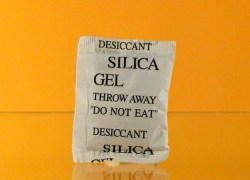Send your question to Umbra!
Q. Dear Umbra,
Do you have any advice on disposal/recycling of those gel packs that come with our pills/vitamins/shoes/protein powders/etc? Surely just throwing them away cannot be safe (wildlife consumption is my biggest worry) — is there anything you can recommend? Also, I feel like I am wasting those cotton balls that come in vitamin and pill bottles, too. I surely couldn’t reuse them as cotton balls, could I?
Casie
La Verne, Calif.

Photo by jojomelons.
A. Dearest Casie,
While I admire your instincts and commitment, I wish I could invent a Take-a-Deep-Breath-It’ll-Be-Okay vitamin, mass produce it today, and mail you a case. I can think of a few others who might benefit from this miracle pill, too. I would not, of course, include silica gel or wads of cotton in said packages.
I know those of us who care deeply about the planet tend to worry about throwing anything away, but I also occasionally encourage people to give themselves a break. This is one of those moments. You are lovely to worry about wildlife eating these little packets, but you needn’t: I checked with two people from the National Wildlife Federation (NWF), whose slightly bewildered responses amounted to, “No, not a concern.” We hope the solid-waste authorities there in La Verne are keeping your garbage under wraps, but even if they’re not, my NWF friends say animals would be unlikely to eat silica gel, because it’s odorless. The ASPCA also says silica gel is relatively harmless, unless large quantities are eaten by tiny animals.
In fact, Casie, I think you’ve unearthed the world’s first case of an industry overhyping its dangers, rather than downplaying or denying them. As you probably know, silica gel is used in various places — shoeboxes, pill bottles, even museum exhibits — to keep products dry; this carefully manufactured substance is a desiccant that can adsorb up to 40 percent of its weight in moisture. You see those little warnings all over the place: “do not eat,” “throw away,” and so forth. But it turns out silica packets are not overly harmful. The exception, and this is a big exception, is if the gel is blue (or pink when wet), which means it’s been treated with cobalt chloride, a suspected carcinogen. Please note, I am not suggesting that anyone eat silica gel of any color or type. Do not eat silica gel. Thank you.
Anyhow, Casie, I’ve rambled my way to the good news: These little packets can do lots of nifty things around the house, like defogging camera lenses and windshields, keeping tools from rusting, protecting old papers, and the list goes on. I’ll bet you can find a way to use them instead of throwing them out! Another thing you could do, of course, is buy fewer shoes, vitamins, and protein powders. We should all buy less stuff in general. Based on your level of concern, I have an inkling that you’re already making a solid effort on that front.
As for the cotton-ball conundrum, which was famously and hilariously taken up by the late Andy Rooney: I am all in favor of reuse, generally, but I would not suggest you substitute these items for your everyday cotton balls. Just so you know, they’re often made of rayon or polyester. (So are some “cotton balls,” actually, so make sure you read your labels.) They’ve also been in close contact with medicine. By the way, the official word from the National Institutes of Health is to take out the cotton, not leave it in the bottle. The only purpose this material serves is to keep the pills from bashing against each other during shipping.
Some people suggest using the cotton for craft projects or cleaning, but I think your best bet is to choke back a Take-a-Deep-Breath-It’ll-Be-Okay vitamin ™ and just throw it away.
Desiccantly,
Umbra



